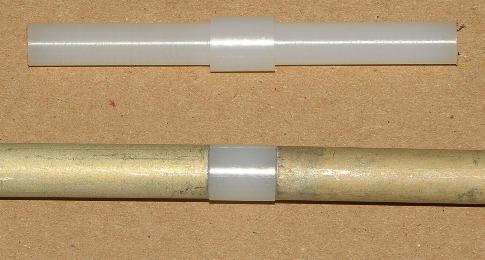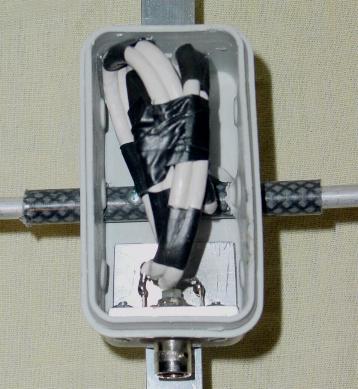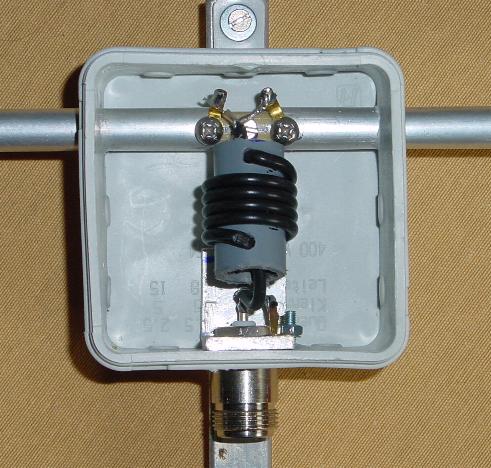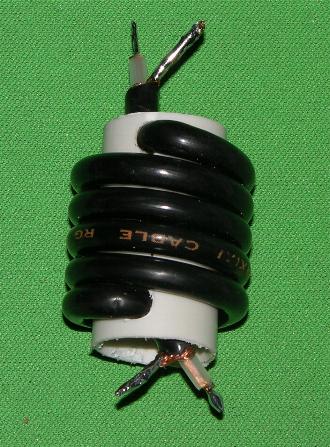2m-Yagis with the 28-Ohm-DK7ZB-Match
(Matching with the DK7ZB-Choke for the 50-Ohm-Yagis see down!)
![]()
Short means, that these Yagis have not the length for EME-groups... All Yagis have a stretched dipole (the lengths in the tables
are from tip-to tip), for the details see
|
The dimensions given for the Yagis in this
chapter are for non-conductive booms like PVC. If the elements are
mounted through or very close to a conductive boom, you need a
proportional correction factor depending on the distance of the
element to the boom. This assembly will cause an electrical
“shortening” of the element, that means it is shorter. This must be
corrected through a corresponding extension of the element.
|
The given length of the radiator element is from tip to tip, including 10mm spacing for the insulated part.
|
|
The elements are mounted insulated with Polyamid-clamps (Nuxcom), the screw in the electrical "zero-point" has no influence to the length of the element and is connected to the boom. "Insulated" means, that no part of the element is "short-cut" by the metal of the boom. Boom 15x15mm for the 4-, 5- and 6-Ele.-Yagi Boom 20x20mm for the 7- and 8-Ele.-Yagi |
|
|
|
|
Clamps for 20x20mm-Boom and 25x25mm-Boom distributed by Henryk, SP6GWN e-mail:[email protected]
For 15x15mm and 20x20mm-clamps try it at www.nuxcom.de
|
|
| Polyamid-clamps and the middle parts for the radiators
right are available at Nuxcom.
|
 |
![]()
|
If you use not-insulated mounting through the boom, you need a correction factor. The element must be longer, because a part of it is electrically shortened. The boom correction for some diameters is as follows:
The boom correction uses the famous DL6WU-formula: C = (12.5975-114.5 * B) * B * B C=Correction factor for one element half (for full element x2) in wavelengths B=Boom diameter in wavelength If you realise an insulated mounting through the boom, take the half of the correction factor above For very long Yagis with small bandwidth it is better to mount the elements insulated, because the factor must be seen in relationship to the reactance of the elements, that means another factor for the shorter directors. With a constant factor you can change the performance of your Yagi to worse conditions.
|
The box with the 2xlambda/4-75Ohm-coax and the socket, two different antennas
|
|
The Box of the 4-El.- Yagi with 1m Boom and 10mm radiator |
| With CATV-cable (full
PE) of 34,5cm length you can mount the cable as a choke in a small box
for a better waterproof construction.
This is the 4-El.-28Ohm with 0,76m boom and 6mm radiator. |
 |
2m-Yagis with the 50-Ohm-DK7ZB-Choke
![]()
 |
The Yagis with an impedance of 50Ohm reach not the highest gain and the best patterns, but they are very uncritical for constructing and very good objects for beginners. I use stretched dipoles with an isolated middle part and a coaxial lambda/4-choke. The choke has 5 windings with RG-174 (for 100Wtts) or RG-188- Teflon (for 200Wtts) on a piece of PVC-tube with 16mm diameter. One end of the choke is connected to the radiator, the other side is connected to a coax-socket which should be grounded to the boom. |
|
There are no currents on the shield of the cable and you can get a very good SWR of 1,0! The Yagis work without any corrections, if you use the given data. You can use this construction instead a 200/50-Ohm folded dipole (easier to tune!) in other descriptions. Right is a choke with RG 58 coax of good MIL-quality. There are some inferior cables on the market for CB-use with a very thin shield, avoid such products! Use cable with a full-PE insulation, foam cable is very bad for bending it to a choke. This choke has 5 turns on a 20mm-PVC-tube and can handle 200 Wtts CW/SSB. With these chokes you have no common mode currents on the outer side of the coax-shield and a symmetrical pattern. |
 |